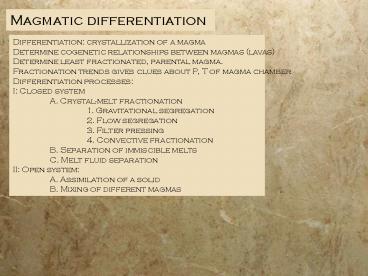Magmatic differentiation - PowerPoint PPT Presentation
1 / 24
Title:
Magmatic differentiation
Description:
Magmatic differentiation Differentiation: crystallization of a magma Determine cogenetic relationships between magmas (lavas) Determine least fractionated, parental ... – PowerPoint PPT presentation
Number of Views:1293
Avg rating:3.0/5.0
Title: Magmatic differentiation
1
Magmatic differentiation
Differentiation crystallization of a
magma Determine cogenetic relationships between
magmas (lavas) Determine least fractionated,
parental magma. Fractionation trends gives clues
about P, T of magma chamber Differentiation
processes I Closed system A. Crystal-melt
fractionation 1. Gravitational segregation 2.
Flow segregation 3. Filter pressing 4.
Convective fractionation B. Separation of
immiscible melts C. Melt fluid separation II
Open system A. Assimilation of a solid B.
Mixing of different magmas
2
Variation diagrams
Harker diagrams Oxide-oxide variation diagrams
Lever rule applies
Liquid moves away from the composition of the
crystallizing assemblage
3
Variation diagrams contd
Resorbed olivines, constant composition of
phenocrysts
4
Trace element modeling
Compatible element concentrations decrease
quickly Incompatible element concentrations
increase slowly
m is melt and p is parent
5
Assimilation
Assimilation of crustal material often better
recognized with isotopes
Assimilation of mafic material hard to
recognize. Data often permissive, but not
conclusive. Evidence crustal xenoliths, resorbed
qtz, trace elements, isotopes.
6
Basaltic intrusions
Palisades sill example of gravitational settling
- Evidence
- Olivine rich layer at the bottom changes in
thickness based on the underlying topography - Sharp change in olivine abundance going upwards
- Olivines are more Fe-rich than what is expected
based on the chilled margin - Local internal chilled contacts new influx
7
Layered intrusions
Name, Location Age Remarks
Skaergaard, Greenland 55.7 55km2 3.5km thick
Rum, Scotland 61-58 115km2gt2km thick
Duluth, MN 1100 More the dozen layered intrusionsgt5000km2
Muskox, NWT, Canada 1270 Canoe shaped 11x 150km
Sudburry, Ontario 1850 1100km2, impact?
Bushveld, South Africa 2050 65000km2, 7-9km thick, remarkably continuous layers
Jimberlana, Australia 2370 Canoe shaped complexes, underlain by dike 1.5km wide, 180km long
Great Dyke, Zimbabwe 2460 4 canoe complexes, 4-11km wide 550km long
Stillwater, Montana 2700 8 x 55 km 7km thick, basal ultramafics, gabbros and anorthosites preserved
Windimurra, Western Australia 2800 25 x 85 km 5-13km only slight differentiation
8
Cumulus fabric
Muskox
9
Skaergaard
Extreme Fe-enrichment
Phase layering changes in mineralogy Cryptic
layering changes in chemical composition of the
minerals
10
MORB fractionation trends
Fractionation trend toward Fe-enrichment.
Where is the primary magma? High P melts to low
P olivine fractionation
11
Fe-enrichment
Tholeiitic trend shows Fe-enrichment. Lack of
enrichment in calc-alkaline trend Higher oxygen
fugacity Fe-oxide stable at higher temperature
i.e. fractionates earlier in the sequence
12
Tonga-Kermadec-New Zealand Arc
Ocean-ocean in North, ocean-continent at New
Zealand
- Often a bimodal distribution in silica
- Taupo rhyolite field in New Zealand, too large a
volume for simple fractionation - Large addition of crustal melts.
- Complicating factors at continental arcs
- Sediment from continent gets subducted enhancing
felsic magma - Subcontinental lithosphere has been
metasomatically enriched over time - The thicker continental crust results in more
opportunity for assimilation.
13
Assimilation
Combined crystallization and assimilation
14
Medicine Lake
Incompatible and compatible element
concentrations to high for fractional XX AFC more
likely, but component of mixing required.
15
Magmatic petrotectonic associations
Spreading centers
16
Spreading center contd
17
Plume at the ridge
18
Plumes
19
Hawaii contd
20
Plumes contd
21
Flood basalts
22
Flood basalts contd
23
Island arcs
Trace elements in island arc rock
distinct Depletion in high field strength
elements (Ti, Zr, Hf, Nb, Ta) In oceanic settings
the HREE can be more depleted then MORB
24
Rift volcanics
Carbonatite gt50 carbonate minerals alkali
carbonatite lt0.2wt SiO2Al2O3. Related to
strongly Si-undersaturated rocks phonolite,
nephelinite, melilitite, hawaiite. Strongly
enriched in LIL large ion lithophile elements.
Alkalic rarities
Lamprophyres, lamproites, orangeites and
kimberlites Potassic, volatile rich, mafic to
ultramafic































